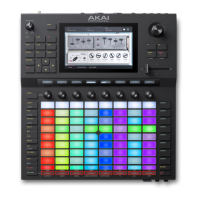249
Glossary
This glossary briefly defines and explains many of the technical terms used throughout this manual.
ftertouch
The majority of contemporary keyboards are capable of generating aftertouch messages. On this
type of keyboard, when you press harder on a key you are already holding down, a MIDI aftertouch
message is generated. This feature makes sounds even more expressive (e.g., through vibrato).
liasing
liasing is an audible side effect arising in digital systems as soon as a signal contains harmonics
higher than half the sampling frequency.
mount
Describes to which extent a modulation source influences a given parameter.
mplifier
n amplifier is a component that influences the volume level of a sound via a control signal. It
can be modulated by a control signal (e.g., generated by an envelope or an LFO).
ttack
n envelope parameter. This term describes the ascent rate of a time-relevant process (e.g., an
envelope from its starting point to the point where it reaches its highest value). The attack phase
is initiated immediately after a trigger signal is received (e.g., after you play a note on a trigger
pad or a keyboard).
Bit Rate
Bit rate (also known as word length), is the number of bits used to store the level information of
each single sample slice within a whole sample. The higher the bit rate, the more precise the
information about a sample (i.e., its dynamics’ resolution). Normal audio CDs are 16-bit. The
Force hardware supports full 24-bit resolution.
Clip
clip is a container for recorded audio or MIDI information. Clips that share a common type,
such as clips of a particular drum kit or plugin, are grouped into tracks. Clips across multiple
tracks in the same row are grouped into scenes.
Each MIDI clip contains MIDI note events and controller data. In this case, the clip contains no
audio information—only MIDI information that uses the samples in a track (or an external MIDI
sound module) to generate its audio. You can edit your performance in many different ways once
the performance has been captured.
Each audio clip contains an audio signal that has been recorded or imported into your project.
You can edit this audio within the software and incorporate it into your projects alongside your
MIDI clips.
Clipping
Clipping is a sort of distortion that occurs when a signal exceeds the maximum value that can be
handled by a signal processing system it is fed into. The curve of a clipped signal is dependent
on the system where the clipping occurs. In the analog domain, clipping effectively limits the
signal to a given maximum level. In the digital domain, clipping is similar to a numerical overflow,
resulting in negative polarity of the signal’s portions exceeding the maximum level.
Control Change
(Controllers)
MIDI messages enable you to manipulate the behavior of a sound generator to a significant
degree. This message essentially consists of two components:
• The controller number, which defines the parameter to be influenced. It can range from 0
to 127.
• The controller value, which determines the extent of the modification.
Controllers can be used for effects such as slowly swelling vibrato, changing the stereo panning
position and influencing filter frequency.
Cutoff The cutoff frequency is a significant factor for a filte
. A low-pass filter for example dampens the
portion of the signal that lies above this frequency. Frequencies below this value are allowed to
pass through without being processed.

